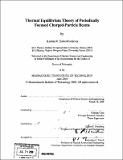| dc.contributor.advisor | Chiping Chen. | en_US |
| dc.contributor.author | Samokhvalova, Ksenia R | en_US |
| dc.contributor.other | Massachusetts Institute of Technology. Dept. of Nuclear Science and Engineering. | en_US |
| dc.date.accessioned | 2009-03-16T19:43:04Z | |
| dc.date.available | 2009-03-16T19:43:04Z | |
| dc.date.copyright | 2008 | en_US |
| dc.date.issued | 2008 | en_US |
| dc.identifier.uri | http://hdl.handle.net/1721.1/44788 | |
| dc.description | Thesis (Ph. D.)--Massachusetts Institute of Technology, Dept. of Nuclear Science and Engineering, 2008. | en_US |
| dc.description | Includes bibliographical references (p. 123-126). | en_US |
| dc.description.abstract | A thermal equilibrium theory of periodically focused charged-particle beams is presented in the framework of both warm-fluid and kinetic descriptions. In particular, the thermal beam equilibria are discussed for paraxial beams in periodic solenoidal and quadrupole magnetic focusing fields, and the theory is compared with the experimental measurements. A warm-fluid equilibrium theory for a thermal beam in a periodic solenoidal focusing field is presented. The warm-fluid beam equilibrium equations are solved in the paraxial approximation, and the beam density and flow velocity are obtained. The self-consistent root-mean-square (rms) beam envelope equation and the self-consistent Poisson equation, governing the beam density and potential distributions, are derived. The beam equilibrium is adiabatic, i.e., there is no heat flow in the system, which results in rms beam emittance being conserved. The beam temperature is constant across the cross-section of the beam. For high-intensity beams, the beam density profile is flat in the center of the beam and falls off rapidly within a few Debye lengths at the edge of the beam. Such density profile provides a more realistic representation of a laboratory beam than the uniform density profile in the Kapchinskij-Vladimirskij beam equilibrium which had been used in experimental data analyses. A kinetic equilibrium theory for the thermal beam in the periodic solenoidal focusing field, which is equivalent to the warm-fluid equilibrium theory, is also presented. The Hamiltonian for single-particle motion is analyzed to find the approximate and exact invariants of motion, i.e., a scaled transverse Hamiltonian (nonlinear space charge included) and the angular momentum, from which a Maxwell-Boltzmann-like beam equilibrium distribution is constructed. | en_US |
| dc.description.abstract | (cont.) The approximation of the scaled transverse Hamiltonian as an invariant of motion is validated analytically for highly emittancedominated beams and highly space-charge-dominated beams, and numerically tested to be valid for cases in between with moderate vacuum phase advances ([sigma]v, < 90°). The beam envelope and emittances are determined self-consistently with the beam equilibrium distribution. A warm-fluid equilibrium theory for a thermal beam in a periodic quadrupole magnetic (AG) focusing field is presented. The beam equilibrium is adiabatic. The warm3 fluid beam equilibrium equations are solved in the paraxial approximation. The rms beam envelope equations and the self-consistent Poisson equation, governing the beam density and potential distributions, are derived. It is shown numerically that the equilibrium equipotential contours and constant density contours are ellipses. Because the thermal beam equilibrium is adiabatic, the 4D thermal rms emittance of the beam is conserved. For high-intensity beams, the beam density profile is flat in the center of the beam and falls off rapidly within a few Debye lengths, which is similar to the beam density profile in the periodic solenoidal focusing field. An interesting property of the equilibrium is that the rate at which the density falls is transversely isotropic. Quantitative comparisons are made between the thermal equilibrium theories and recent experiments at the University of Maryland Electron Ring [S. Bernal, B. Quinn, M. Reiser and P. G. O'Shea, Phys. Rev. Special Topics - Accel. Beams 5, 064202 (2002); S. Bernal, R. A. Kishek, M. Reiser, and I. Haber, Phys. Rev. Lett. 82, 4002 (1999)]. In the case of the periodic solenoidal focusing experiment, good agreement is found between theory and the experimental measurements from the anode aperture to a distance prior to wave breaking. | en_US |
| dc.description.abstract | (cont.) In the case of the AG focusing experiment, there is reasonably good agreement between the theoretical and experimentally measured density profiles in one transverse direction along which the beam is close to equilibrium. | en_US |
| dc.description.statementofresponsibility | by Ksenia R. Samokhvalova. | en_US |
| dc.format.extent | 136 p. | en_US |
| dc.language.iso | eng | en_US |
| dc.publisher | Massachusetts Institute of Technology | en_US |
| dc.rights | M.I.T. theses are protected by
copyright. They may be viewed from this source for any purpose, but
reproduction or distribution in any format is prohibited without written
permission. See provided URL for inquiries about permission. | en_US |
| dc.rights.uri | http://dspace.mit.edu/handle/1721.1/7582 | en_US |
| dc.subject | Nuclear Science and Engineering. | en_US |
| dc.title | Thermal equilibrium theory of periodically focused charged-particle beams | en_US |
| dc.type | Thesis | en_US |
| dc.description.degree | Ph.D. | en_US |
| dc.contributor.department | Massachusetts Institute of Technology. Department of Nuclear Science and Engineering | |
| dc.identifier.oclc | 300301185 | en_US |
